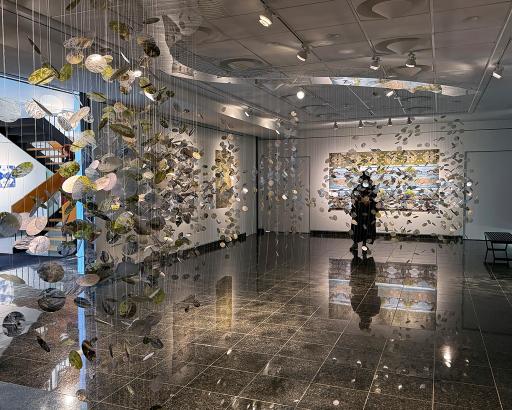Hannah Claus
Pronouns: She/Her
Thesis supervisor Accepting inquiries
- Associate Professor, Studio Arts
Are you the profile owner?
Sign in to editResearch areas: Contemporary art, Indigenous Contemporary Art, Studio Art, Installation, Sculpture, Fibre Arts, Photography, Video, Wampum Belts, Kanien'kehá:ka, Haudenosaunee
Contact information
Biography
BIOGRAPHY
Hannah Claus utilizes material and sensorial relationships within her studio practice to express Kanien’kehá:ka ways of knowing and understanding. Recipient of the Eiteljorg Fellowship (2019) and the Prix Giverny (2020), recent group exhibitions include Contextile: Biennial of Contemporary Textile Art (Guimarães, Portugual), Outside the Box (Iroquois Museum, Howes Cave NY) and the North American touring exhibition, Radical Stitch. Her solo exhibition, tsi iotnekahtentiónhatie [where the waters flow] will be exhibited at the Canada House Gallery in London, England in October 2025. Her artwork belongs to various public collections, including the National Gallery of Canada, the Montreal Museum of Fine Arts, the Winnipeg Art Gallery, among others. She is in the final stages of producing a major public art installation at the Centre Sanaaq for the City of Montreal. Claus served as a board member of the Indigenous Curatorial Collective (2013-2018), the Conseil des arts de Montréal (2017-2023) and is a co-founder Quebec’s first Indigenous-led artist-run centre, daphne (2019-ongoing). She holds a Concordia University Research Chair in Onkwehonwené:ha (New Scholar), and is Co-director of the Indigenous Futures Research Centre. Claus is a member of Kenhtè:ke | Tyendinaga Mohawks of the Bay of Quinte.
Teaching areas include Studio Arts (ARTX - Interdisciplinary Arts), Fibres and Material Practices (Structures, Special Topics and MFA Studio) and MFA seminar and studio. See below for examples of courses developed by Prof Claus.
Research activities
where the waters flow
An Insight Development Grant received to develop research-creation (installations and "art walks") on Tiohtià:ke as a Kanien'kehá:ka territory

the language of the land

water song [Kahrhiona'kó:wa], 2024
Teaching activities
ARTX 398 Decoration and Pattern as Language
Pattern has long existed as language, communicating histories, familial lineage, conflicts and clans through imagery and repetition. The material means by which these are transmitted has been highly influenced by specificity of place, but has also evolved through trade, as nations and cultures come into contact. In this course, we will explore how decoration and patterning contribute meaning to two-dimensional and three-dimensional artistic practices through an interdisciplinary and decolonial lens. Course content focuses primarily upon First Nations, Métis and Inuit visual cultures and contemporary artists, presented through in-class workshops, media and active learning.
ASEM 644 Indigenous Perspective(s) on Time, History, and the Intersections of Museum and Monument
The dissonance that exists between Indigenous and Western understandings of time has had significant consequences on the construction, canonization, and experience of History, which continues to shape and define our realities today. These constructions impact and disturb the codification of memory within the public sphere through institutional frameworks and display, as represented by museum practices and monuments. Utilizing critical texts from various Indigenous scholars, such as Karyn Recollet, Deborah Doxtator and Leroy Little Bear, among others, as well as guest lectures and engaging with Indigenous artworks (contemporary and historical), this seminar will examine with the role of time within Indigenous worldview(s) in order to better understand, and build, a possible trajectory for decolonizing methodologies.


